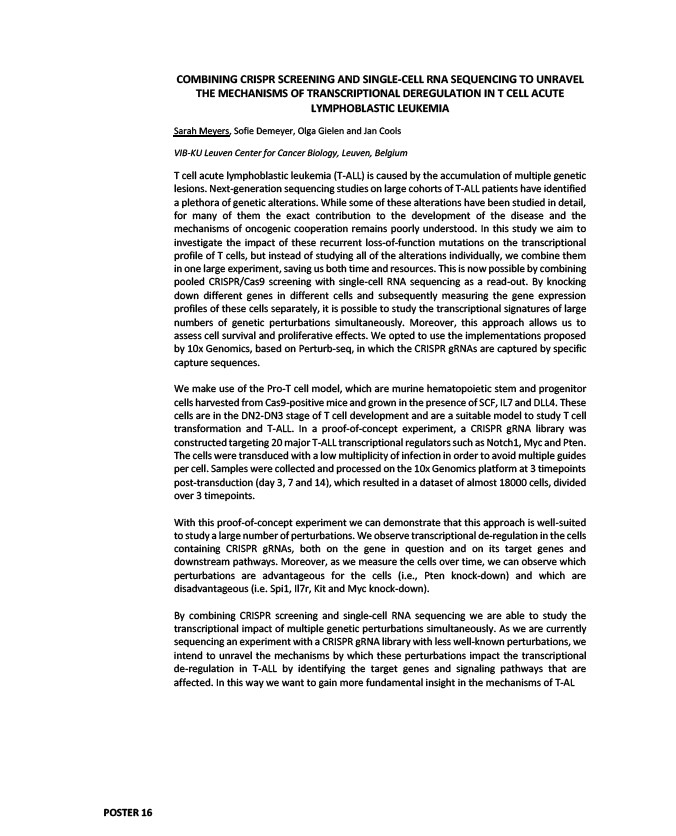
COMBINING CRISPR SCREENING AND SINGLE-CELL RNA SEQUENCING TO UNRAVEL
THE MECHANISMS OF TRANSCRIPTIONAL DEREGULATION IN T CELL ACUTE
LYMPHOBLASTIC LEUKEMIA
Sarah Meyers, Sofie Demeyer, Olga Gielen and Jan Cools
VIB-KU Leuven Center for Cancer Biology, Leuven, Belgium
T cell acute lymphoblastic leukemia (T-ALL) is caused by the accumulation of multiple genetic
lesions. Next-generation sequencing studies on large cohorts of T-ALL patients have identified
a plethora of genetic alterations. While some of these alterations have been studied in detail,
for many of them the exact contribution to the development of the disease and the
mechanisms of oncogenic cooperation remains poorly understood. In this study we aim to
investigate the impact of these recurrent loss-of-function mutations on the transcriptional
profile of T cells, but instead of studying all of the alterations individually, we combine them
in one large experiment, saving us both time and resources. This is now possible by combining
pooled CRISPR/Cas9 screening with single-cell RNA sequencing as a read-out. By knocking
down different genes in different cells and subsequently measuring the gene expression
profiles of these cells separately, it is possible to study the transcriptional signatures of large
numbers of genetic perturbations simultaneously. Moreover, this approach allows us to
assess cell survival and proliferative effects. We opted to use the implementations proposed
by 10x Genomics, based on Perturb-seq, in which the CRISPR gRNAs are captured by specific
capture sequences.
We make use of the Pro-T cell model, which are murine hematopoietic stem and progenitor
cells harvested from Cas9-positive mice and grown in the presence of SCF, IL7 and DLL4. These
cells are in the DN2-DN3 stage of T cell development and are a suitable model to study T cell
transformation and T-ALL. In a proof-of-concept experiment, a CRISPR gRNA library was
constructed targeting 20 major T-ALL transcriptional regulators such as Notch1, Myc and Pten.
The cells were transduced with a low multiplicity of infection in order to avoid multiple guides
per cell. Samples were collected and processed on the 10x Genomics platform at 3 timepoints
post-transduction (day 3, 7 and 14), which resulted in a dataset of almost 18000 cells, divided
over 3 timepoints.
With this proof-of-concept experiment we can demonstrate that this approach is well-suited
to study a large number of perturbations. We observe transcriptional de-regulation in the cells
containing CRISPR gRNAs, both on the gene in question and on its target genes and
downstream pathways. Moreover, as we measure the cells over time, we can observe which
perturbations are advantageous for the cells (i.e., Pten knock-down) and which are
disadvantageous (i.e. Spi1, Il7r, Kit and Myc knock-down).
By combining CRISPR screening and single-cell RNA sequencing we are able to study the
transcriptional impact of multiple genetic perturbations simultaneously. As we are currently
sequencing an experiment with a CRISPR gRNA library with less well-known perturbations, we
intend to unravel the mechanisms by which these perturbations impact the transcriptional
de-regulation in T-ALL by identifying the target genes and signaling pathways that are
affected. In this way we want to gain more fundamental insight in the mechanisms of T-AL
POSTER 16